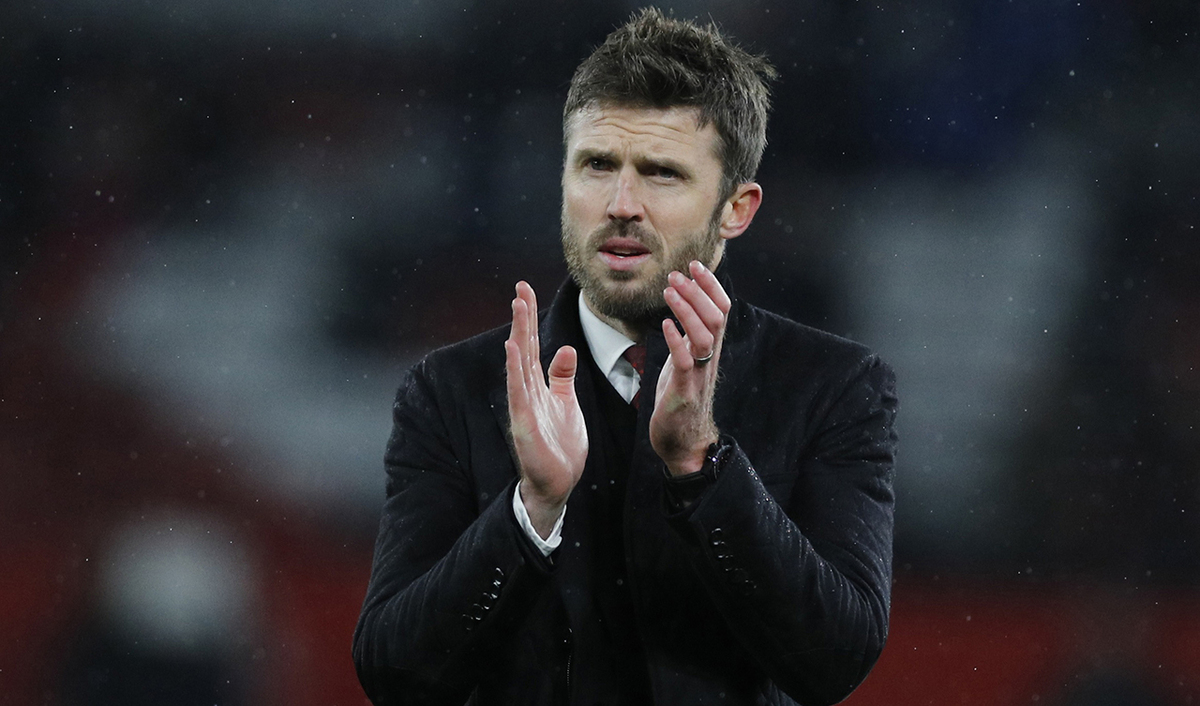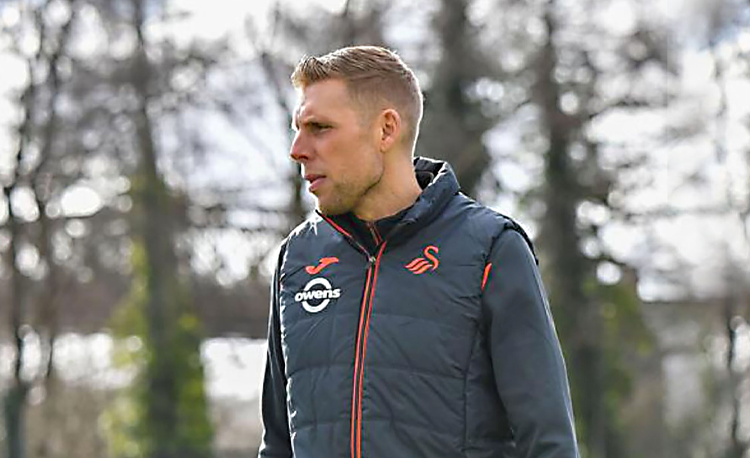You are viewing 1 of your 1 free articles
Combining to progress through the pitch
| Area | Up to full pitch |
| Equipment | Balls, bibs, cones, 2 mannequins, 6 small goals, 2 full size goals |
| No. of Players | 20 players + 2 goalkeepers |
| Session Time | Passing routine: 12mins Breaking forward: 10mins 11v11 game: 14mins |
This session is about working together to open up space on the pitch so the team can penetrate opponents quickly by passing forward and breaking lines.
It shows players how to pick the right moment to penetrate and it helps to develop the relationship between the players, both on and off the ball.
If they are on the same wavelength they are more likely to recognise the triggers and to be able to use the correct angle and speed of pass and the right angle and timing of supporting runs and lay-offs.
It’s about flowing through the pitch with momentum and rhythm, and working on the skills and processes that can be used in all areas. It’s the principles that are important in this session rather than specific positions.
There are three parts to this session but quite often I’d maybe only use one or two, depending on what other work needs to be done on any given day.
It’s a very flexible session in terms of numbers and pitch sizes, depending on how challenging you want it to be.
I feel players engage with this session because it is focused on positive attacking play and also because they have an element of freedom to explore the possibilities and express themselves within the session.
Key questions that we want the players to ask themselves during this session include: How far forward can I pass? Am I showing to be available on supporting the next pass? Am I holding my position to leave space for somebody else to use?
There is a big emphasis on decision making in this session, meaning the players have to think for themselves instead of being told what to do or being directed. I always feel this separates the best from the rest.
PASSING ROUTINE
The first part of the session allows us to introduce the themes to the players to get them thinking about the topic we’re focusing on. We set up a playing area of approximately 50x30 yards although the size can vary depending on what we want to get from the activity. Two mini target goals are positioned at each end and two mannequins are positioned 20 yards apart on the halfway line. We’re using 10 outfield players.
Player 1 starts with a ball at the bottom end and plays a one-two with player 2. After receiving the return pass player 1 passes the ball into the midfield player waiting by the mannequin on the right side. The midfielder sets for player 2, who runs onto the ball and plays a through pass into the front player. The front player receives and sets for a supporting run across the front from the midfield player waiting on the mannequin on the left. This midfielder aims to finish with a first time shot on an angle into the mini goal, as shown [1a].
[1a]
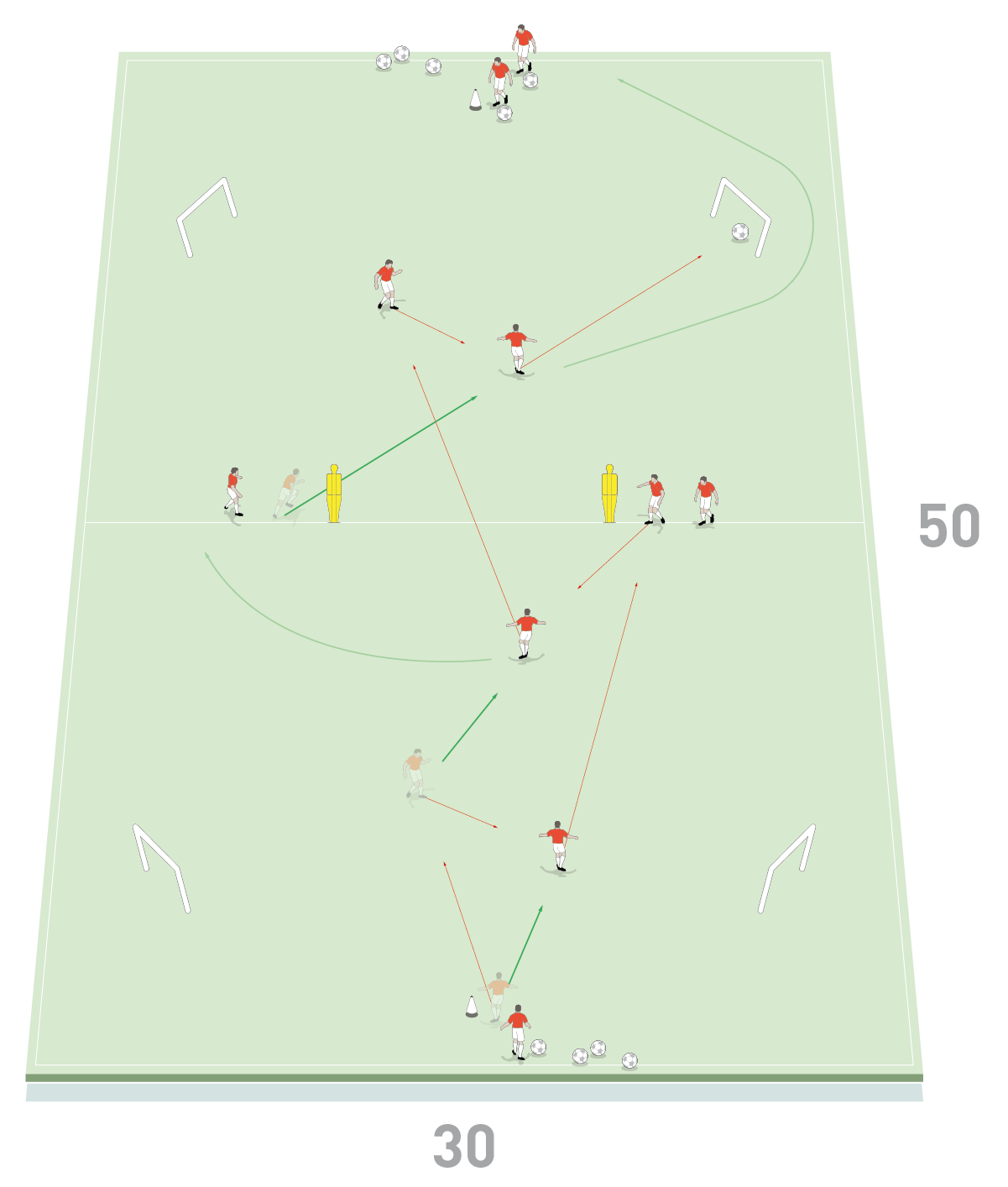
- Player 1 starts with a ball at the bottom end and plays a one-two with player 2 and then passes to the midfielder on the mannequin on the right
- The midfielder sets for player 2, who runs onto the ball and plays a through pass into the front player
- The midfield player on the left makes a supporting run across the front from behind the mannequin
- The front player sets for the midfielder to finish with a first time shot into the mini goal
The player who shoots into the mini goal then joins the back of the queue at the top end. The passing sequence then repeats in the opposite direction using the same passing patterns and movements going from top to bottom this time, as shown [1b].
We would work on the right side for three minutes and then run it on the left side for three minutes, and then repeat on both sides.
To use the whole squad we would usually run the activity on two playing areas side by side.
[1b]
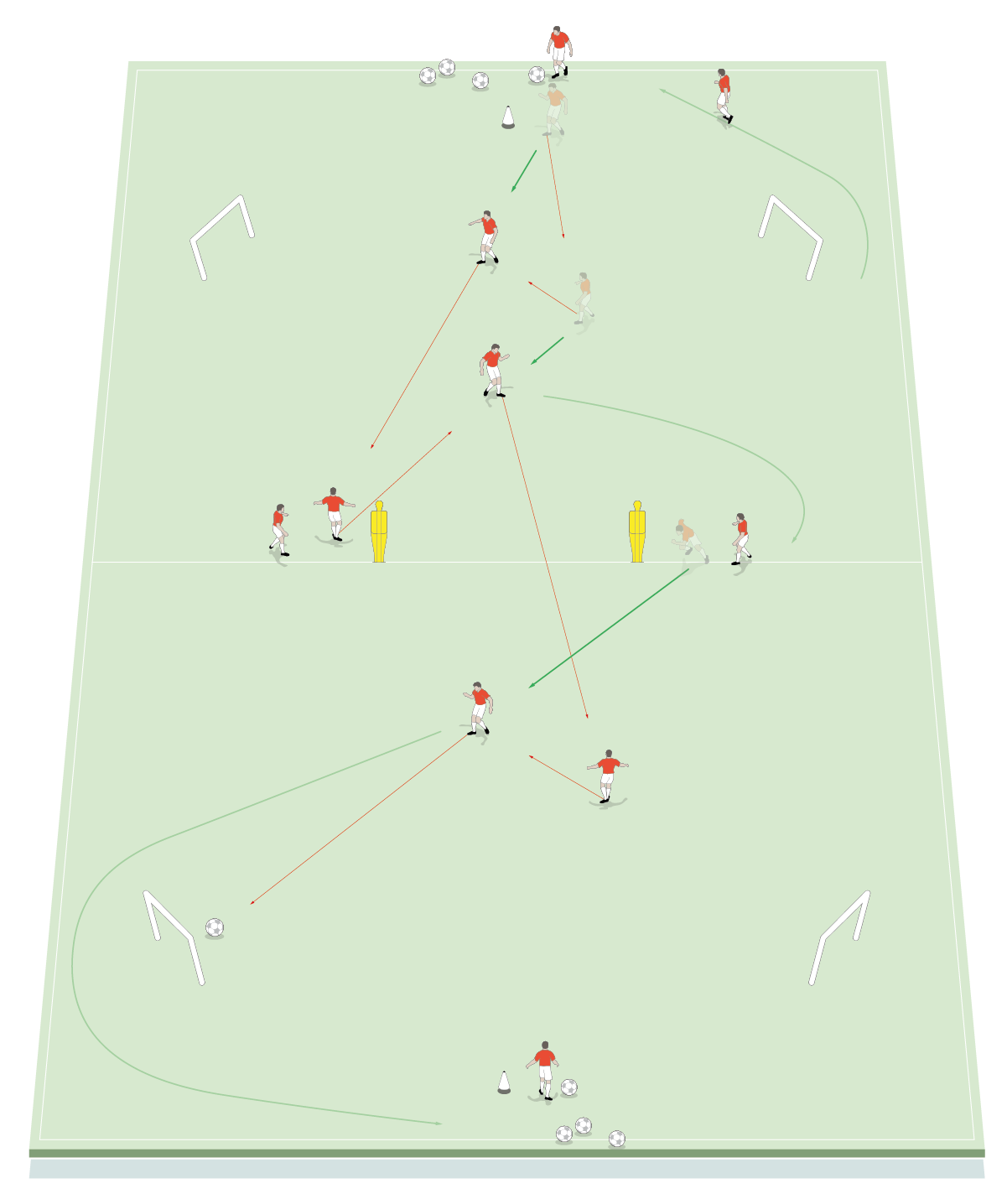
- The player who shoots into the top mini goal joins the back of the queue at the top end after shooting
- The passing sequence then repeats in the opposite direction with the same passing pattern and movements going from top to bottom this time
“The passing sequence repeats in the opposite direction with the same passing patterns and movements going from top to bottom this time”
BREAKING FORWARD
[2]
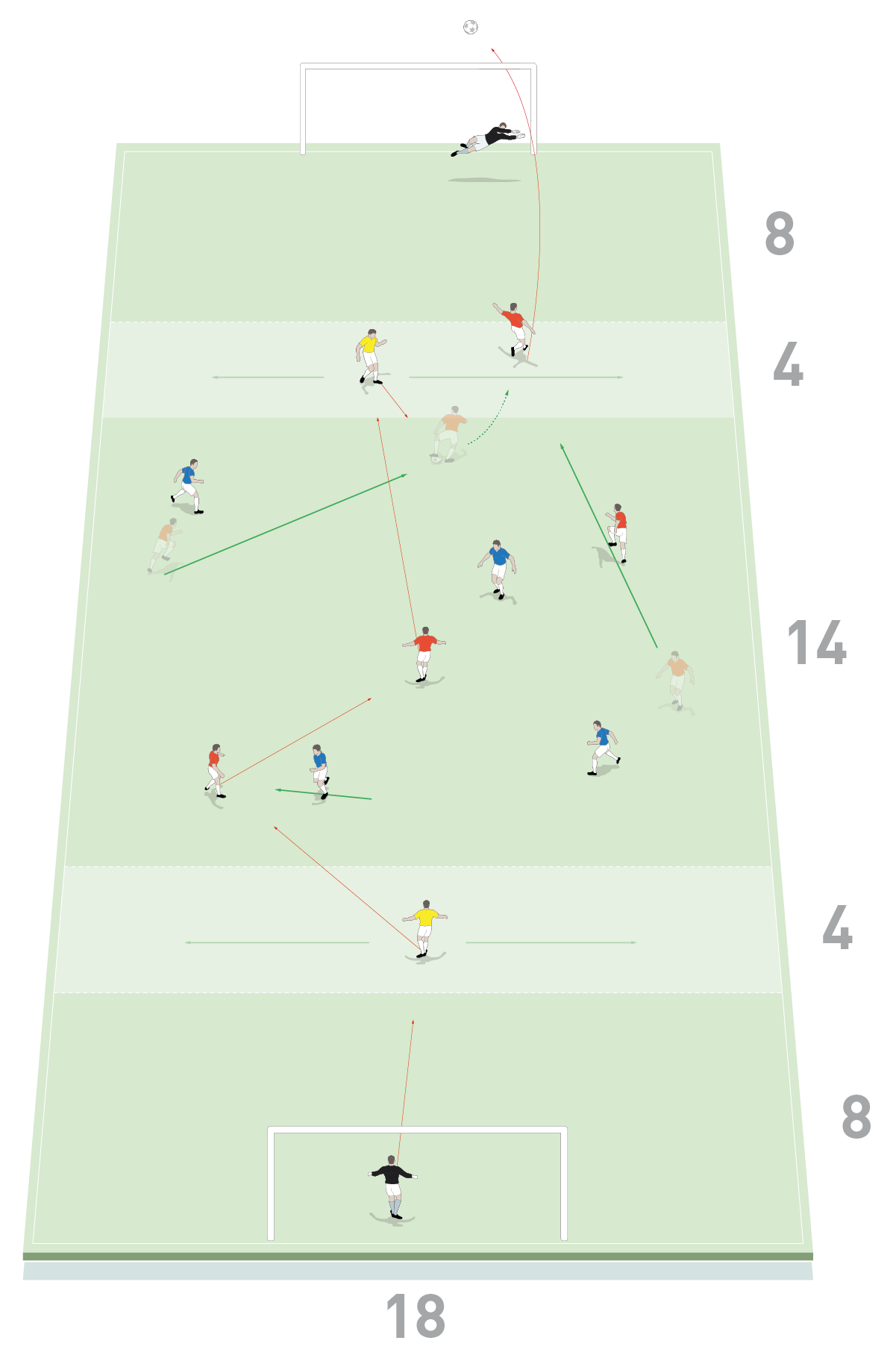
- The keeper starts by passing to the nearest player in the midfield zone. The possession team can’t play it back to the keeper, so they must look for forward passing options
- The yellow neutrals can only move laterally to make passing angles and are restricted to one-touch
- The aim is to play through the opposition and off the neutral to create goal scoring opportunities. If they succeed, the team gets three points
- If it’s not on to play forward, the possession team must pass the ball around to create an opening – they score one point if they make 10 consecutive passes
We progress the session into an opposed small-sided game and work on the same principles highlighted in the first activity.
We set up a playing area of 38x18 yards with a full size goal and a goalkeeper at each end. A midfield area of 22 yards in length includes two four-yard zones for the neutral players. The entire midfield area is sandwiched between two eight-yard end zones for
the goalkeepers, where no outfield players can enter.
We’re using 10 outfield players split into a red team of four and a blue team of four, plus two yellow neutrals who play for the team in possession. Play is directional and the neutrals can only move laterally to make passing angles and are restricted to one-touch.
Play starts with the goalkeeper, who passes either to the nearest neutral or to the nearest player in the midfield zone. Once the ball is in the middle area, they can’t play it back to the goalkeeper, so they must look for forward passing options to progress the play.
The aim is to play through the opposition and off the neutral player to create goal scoring opportunities, as shown [2]. If the team in possession can pass forwards, support the play and score in the goal, they get three points.
If it’s not on to play forward, then the possession team must pass the ball around – if the team makes 10 consecutive passes they score one point. The team in possession must show the required patience to keep hold of the ball while continually looking for a moment to penetrate forwards.
We want to see players off the ball constantly making angles to be available while looking to anticipate and support forward passes. Players must work at being on the same wavelength so they can understand the triggers to penetrate. Also, when attacking the goal they should time their movement so they arrive in space late and fast.
We want to see them playing side on and on the half turn. They should be one step ahead with their passing and movement and with their angle of support.
Be prepared for play to be a bit messy to start with, as players need to experience what works and what doesn’t in order to play on the edge and find their limit – after all, that’s decision making.
As the session progresses defenders improve at blocking passing lanes into the target player. This is when patience and playing clever comes into play and we want to see attackers sucking defenders out in order to play in behind them.
To use the whole squad we would usually run the activity on two playing areas side by side. To make the exercise more challenging, we sometimes use smaller goals. We play two games of four minutes.
11v11 GAME
We set up a long but narrow playing area between the penalty areas of a pitch, measuring approximately 40 yards in width. We position three small goals at each end f the playing area.
We’re using 20 outfield players and two keepers, split into two teams of 11. Each team is set-up in a GK-4-2-3-1 shape.
Play starts with a pass out from a goalkeeper. The game is directional and the goalkeepers build up play as normal from the back but they defend all three mini goals when under attack by the opposition.
The team in possession looks to follow and build on the same principles learnt in the previous parts of the session – the aim is to play forward with combination play and good movement to support the forward pass. The team in possession must play through the opposition and the players try to score in any one of the three mini goals, as shown [3].
Depending on how challenging we want the activity to be, it’s possible to progress it by making two of the players neutrals and encouraging them combine with the team in possession to create an overload situation in the middle of the playing area.
We play two games of six minutes.
[3]

- Each team is set-up in a GK-4-2-3-1 shape. Play is directional and starts with a pass from the keeper, who builds play as normal but who defends all three mini goals when under attack
- The team in possession aims to play through the opposition and score in any one of the three mini goals, using patterns of play learnt in the early parts of the session
“The team in possession must play through the opposition and they try to score in any one of the three mini goals”
Related Files
Editor's Picks
Deep runs in the final third
Using the goalkeeper in build-up play
Pressing principles
Intensive boxes drill with goals
Penetrating the final third
Creating and finishing
My philosophy
Pressing initiation
Compact team movement
Coaches' Testimonials

Alan Pardew

Arsène Wenger

Brendan Rodgers

Carlos Carvalhal

José Mourinho

Jürgen Klopp

Pep Guardiola

Roy Hodgson

Sir Alex Ferguson

Steven Gerrard
Coaches' Testimonials

Gerald Kearney, Downtown Las Vegas Soccer Club

Paul Butler, Florida, USA

Rick Shields, Springboro, USA

Tony Green, Pierrefonds Titans, Quebec, Canada
Join the world's leading coaches and managers and discover for yourself one of the best kept secrets in coaching. No other training tool on the planet is written or read by the calibre of names you’ll find in Elite Soccer.
In a recent survey 92% of subscribers said Elite Soccer makes them more confident, 89% said it makes them a more effective coach and 91% said it makes them more inspired.
Get Monthly Inspiration
All the latest techniques and approaches
Since 2010 Elite Soccer has given subscribers exclusive insight into the training ground practices of the world’s best coaches. Published in partnership with the League Managers Association we have unparalleled access to the leading lights in the English leagues, as well as a host of international managers.
Elite Soccer exclusively features sessions written by the coaches themselves. There are no observed sessions and no sessions “in the style of”, just first-hand advice delivered direct to you from the coach.
